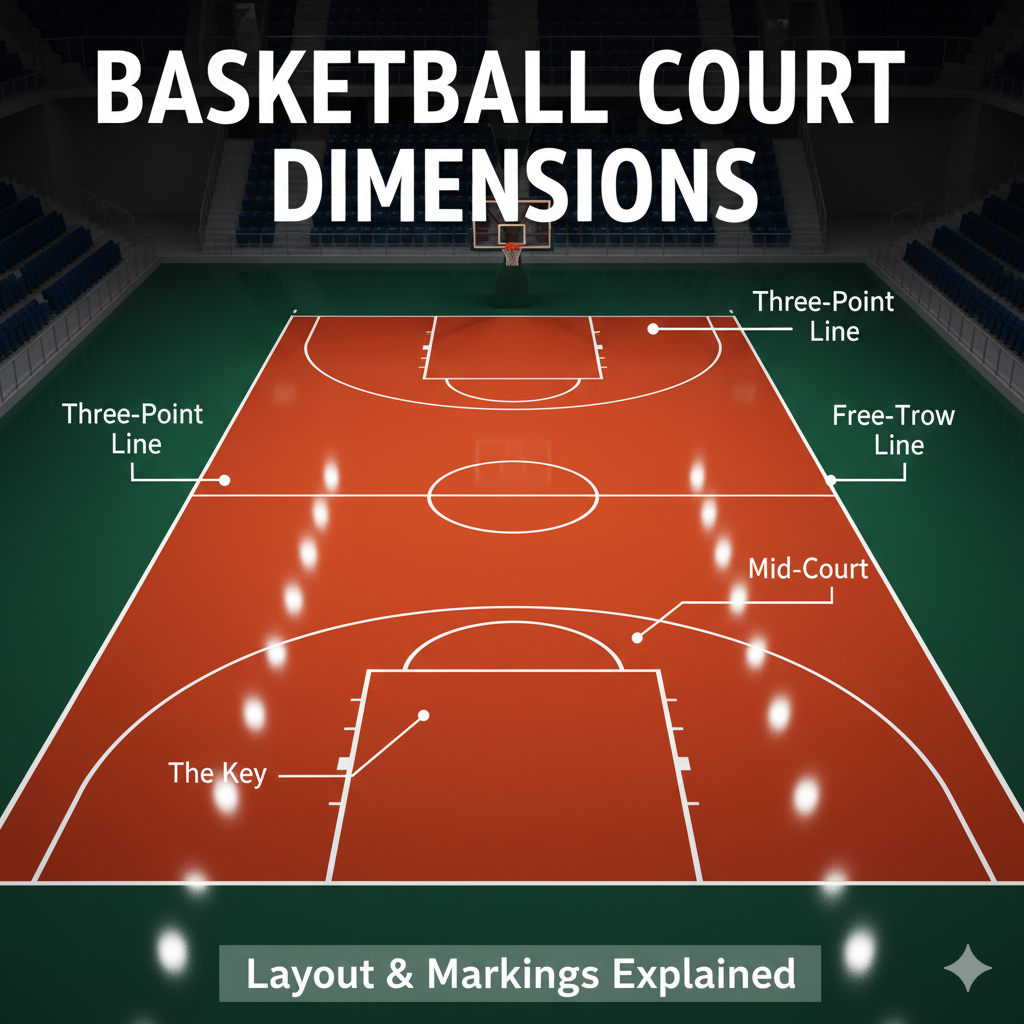
Whether you’re building a professional arena, a school playground, or a backyard court, understanding the basketball court size is essential. Court dimensions directly affect gameplay, movement, and even player safety. This guide explains the official basketball court dimensions, differences across levels (NBA, FIBA, high school), and key markings every builder or player should know.
Official Basketball Court Dimensions
1. NBA (National Basketball Association) Court Size
- Length: 94 feet (28.65 meters)
- Width: 50 feet (15.24 meters)
- Three-Point Line: 23.75 feet (7.24 meters) from the basket
- Free-Throw Line: 15 feet (4.57 meters) from the backboard
- Restricted Area Radius: 4 feet (1.22 meters)
The NBA court size provides players with maximum space for fast movements, complex plays, and three-point shots.
2. FIBA (International Basketball Federation) Court Size
- Length: 28 meters (91.9 feet)
- Width: 15 meters (49.2 feet)
- Three-Point Line: 6.75 meters (22.15 feet)
- Free-Throw Line: 4.6 meters (15.09 feet)
Most international tournaments and Olympic games use FIBA standards. The slightly smaller size compared to the NBA makes the game more compact and strategic.
3. High School & College Basketball Court Size
- Length: 84 feet (25.6 meters)
- Width: 50 feet (15.24 meters)
- Three-Point Line: 19.75 feet (6.02 meters)
- Free-Throw Line: 15 feet (4.57 meters)
These courts are designed for training and educational levels, offering easier maneuverability and promoting teamwork over distance shooting.
Key Court Markings and Layout

A standard basketball court includes the following important markings:
- Center Circle: Used for the opening tip-off; radius of 6 feet (1.83 meters).
- Free-Throw Lane (Paint Area): 16 feet wide in NBA, 12 feet in FIBA.
- Three-Point Arc: Distance varies depending on competition level.
- Sidelines & Baselines: Define the playing boundaries.
- Basket Height: Fixed at 10 feet (3.05 meters) across all levels.
These markings maintain uniformity and fairness across all matches.
Indoor vs Outdoor Basketball Court Size
While the dimensions remain similar, indoor courts usually have hardwood or synthetic surfaces for better bounce and grip.
Outdoor courts, however, use materials like acrylic, concrete, or modular tiles, depending on durability and weather resistance.
For outdoor construction, ensure:
- Proper surface leveling
- Adequate water drainage
- Weatherproof coating for longevity
Mini & Half Basketball Court Sizes
If you’re building a personal or community court:
- Half Court (NBA style): 47 × 50 feet (14.33 × 15.24 meters)
- Half Court (FIBA style): 14 × 15 meters (45.9 × 49.2 feet)
- Mini Court: 30 × 40 feet (9.1 × 12.2 meters) — perfect for practice or residential spaces.
These compact versions maintain proportions while saving space and cost.
Tips for Building a Perfect Basketball Court

Use acrylic or synthetic flooring for shock absorption.
Maintain 10 feet clearance around the court for player safety.
Install anti-glare lighting for night games.
Regularly repaint lines for accuracy and appearance.
Ensure drainage and slope (1%) to prevent water accumulation outdoors.
Basketball Court Size Comparison Table
| Level | Length | Width | Three-Point Line | Free-Throw Line |
|---|---|---|---|---|
| NBA | 94 ft | 50 ft | 23.75 ft | 15 ft |
| FIBA | 91.9 ft | 49.2 ft | 22.15 ft | 15 ft |
| High School | 84 ft | 50 ft | 19.75 ft | 15 ft |
Conclusion
The basketball court size plays a crucial role in how the game unfolds — influencing speed, shot accuracy, and player dynamics. Whether you’re designing for professional athletes or recreational use, following standard measurements ensures a safe and enjoyable playing experience.
If you’re planning to build a custom basketball court, consult sports flooring experts to ensure the correct layout, marking, and surface quality.



